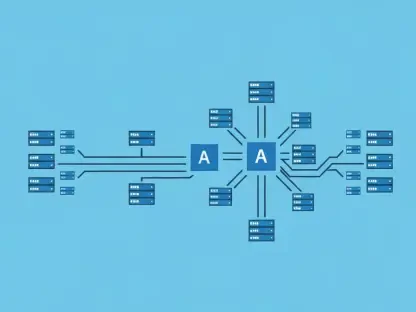In an era where artificial intelligence is reshaping industries at an unprecedented pace, finding the right tools and platforms to deploy cutting-edge models can be a game-changer for businesses and developers alike. Enter DeepSeek-R1-0528, a groundbreaking open-source AI reasoning model that has emerged as a formidable rival to proprietary systems like OpenAI’s o1 and Google’s Gemini 2.5 Pro, boasting an impressive 87.5% accuracy on rigorous AIME tests. This model isn’t just about raw power; its affordability and accessibility make it a compelling choice for a wide range of users, from individual coders to sprawling enterprises. Updated as of August 11, 2025, this guide aims to navigate the complex landscape of deployment options, shining a light on the best providers across cloud APIs, GPU rentals, and local setups. By delving into pricing, performance metrics, and tailored recommendations, the goal is to equip readers with the knowledge needed to harness this powerful technology effectively, ensuring projects thrive in a competitive digital environment.
Unpacking the Power of DeepSeek-R1-0528
DeepSeek-R1-0528 stands as a beacon of innovation in the AI domain, primarily due to its open-source framework that breaks down barriers to advanced reasoning capabilities. Unlike many proprietary models that lock users into high-cost ecosystems, this model offers a cost-effective alternative without sacrificing quality, making it accessible to startups and established firms alike. Its ability to handle complex tasks is enhanced by features such as JSON output formatting and function calling, which streamline integration into diverse applications. Additionally, a notable reduction in hallucination rates ensures outputs are more reliable, a critical factor for industries relying on precise data interpretation. This blend of accessibility and advanced functionality positions the model as a transformative tool, particularly for those seeking to push boundaries in fields like education, research, and technology development.
Beyond its technical prowess, the model’s performance on standardized benchmarks sets a high bar for competitors. Achieving top scores on tests like AIME and HMMT, it demonstrates a capacity for deep reasoning, often processing an average of 23,000 tokens per question to deliver insightful responses. Such metrics highlight why selecting an optimal deployment provider is paramount—pairing this robust model with the right infrastructure can significantly amplify its impact. Whether the focus is on rapid prototyping or long-term production environments, understanding the nuances of its capabilities helps in aligning deployment strategies with specific project goals. This ensures that users can fully capitalize on the model’s strengths, driving efficiency and innovation in their respective domains.
Navigating the Deployment Landscape
The deployment options for DeepSeek-R1-0528 are as varied as the users it serves, offering solutions that cater to different technical proficiencies and financial constraints. Cloud-based API services, such as those provided by the DeepSeek Official platform and Amazon Bedrock, present a user-friendly entry point for those who prioritize ease of access over hands-on control. These platforms often eliminate the need for extensive hardware investments, allowing seamless integration into existing workflows. On the other hand, GPU rental services like Novita AI appeal to users requiring dedicated computational power for customized setups, while local deployment through frameworks like Hugging Face Hub offers autonomy for those concerned with data privacy. Each avenue presents unique advantages, shaped by factors such as scalability needs and operational budgets, making it essential to evaluate them against specific project demands.
Delving deeper into these categories reveals distinct trade-offs that influence decision-making. Cloud API solutions often balance convenience with potential latency issues, particularly in budget-friendly tiers, which may not suit time-sensitive applications. GPU rentals, while powerful, require a level of technical expertise to manage effectively, alongside recurring costs that can add up for long-term projects. Local setups, though free of per-token charges, demand significant upfront investment in hardware and ongoing maintenance efforts. Understanding these dynamics is crucial for aligning deployment choices with operational goals, whether the aim is to test a concept on a tight budget or to roll out a robust system for enterprise-level demands. This broad spectrum of options ensures that every user can find a fitting pathway to leverage the model’s capabilities.
Spotlight on Leading Providers
Among the array of providers facilitating DeepSeek-R1-0528 deployment, several stand out for their tailored offerings across different user needs. The DeepSeek Official API emerges as a frontrunner for cost-conscious projects, with pricing set at a competitive $0.55 per million input tokens and $2.19 per million output tokens, ideal for high-volume applications. In contrast, Amazon Bedrock targets enterprise clients with its serverless architecture and seamless integration into the AWS ecosystem, bolstered by stringent security measures. For those seeking a middle ground, Together AI offers tiered plans that optimize performance without breaking the bank, while Novita AI provides hourly GPU rentals for users needing raw processing power. Local deployment enthusiasts can turn to Hugging Face Hub and Ollama, which support free access to model weights and high-performance inference on personal hardware, ensuring data security.
Further examination of these providers highlights critical performance considerations that shape user experiences. Latency remains a key concern with budget options like the DeepSeek Official API, where cost savings may come at the expense of response speed, potentially impacting real-time applications. Premium services, such as Fireworks AI, prioritize rapid processing with sub-5-second response times, though at a higher price point. Regional availability also plays a role, as some platforms like Amazon Bedrock are limited to specific geographies, necessitating careful planning for global teams. These insights provide a clearer picture of how each provider aligns with distinct operational needs, from small-scale experimentation to large-scale production environments, empowering users to make informed choices based on practical constraints and strategic priorities.
Actionable Guidance for Provider Selection
For those embarking on the journey of deploying DeepSeek-R1-0528, tailored recommendations can streamline the selection process to match specific objectives. Startups and small-scale projects stand to benefit immensely from the DeepSeek Official API, thanks to its low entry cost and occasional off-peak discounts, making it a perfect sandbox for testing innovative ideas without financial strain. Meanwhile, applications geared toward production environments may find a better fit with Together AI or Novita AI, both of which offer scalable solutions designed to handle increased demand with consistent performance. These providers strike a balance between affordability and reliability, ensuring that growing operations aren’t hindered by infrastructure limitations. Matching provider strengths to project scale and scope is a critical step in optimizing outcomes, allowing for efficient resource allocation from the outset.
Enterprises operating within regulated industries or with stringent compliance requirements should gravitate toward solutions like Amazon Bedrock, which integrates robust security protocols and benefits from the broader AWS infrastructure. This choice supports complex needs around data protection and scalability, crucial for large organizations managing sensitive information. On the other end of the spectrum, developers prioritizing control and privacy will find local deployment through Hugging Face paired with Ollama to be an ideal setup, offering freedom from API restrictions and per-token costs while maintaining data on personal hardware. These actionable insights were crafted to guide users through past decisions, reflecting on how various providers met diverse needs. Looking ahead, the focus should shift to piloting with cost-effective options before scaling to more comprehensive systems as requirements evolve, ensuring a strategic approach to leveraging this transformative AI model.









